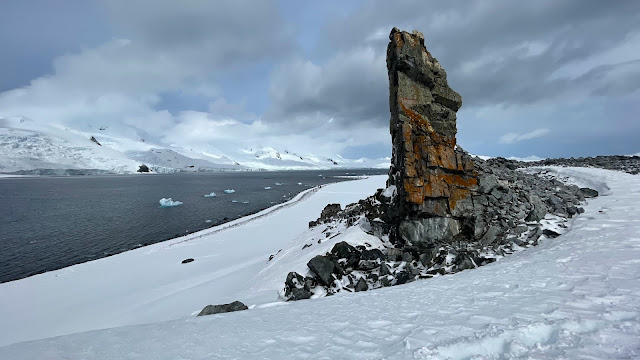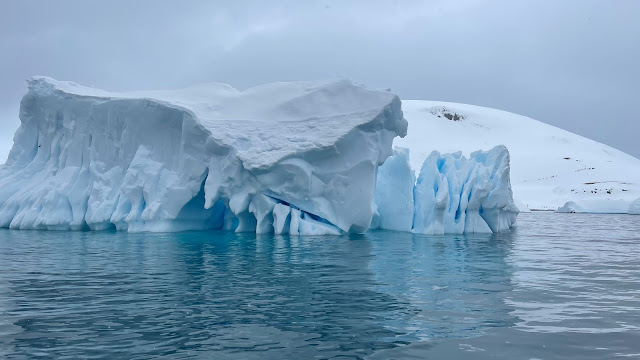Livingston Island with lenticular clouds, December 7,
2021
On Tuesday morning November 9 (not quite seven weeks ago), I received the
following email:
"Hi Wayne, One of our staff members has a family situation that came up
last minute. You were the first one I thought who could replace him. The
dates are November 28 – Dec 12, 2021 – our Total Solar Eclipse cruise.
Please let me know. Thanks, Julia"
I've received a number of inquiries like these through my career, working
as a roving
Geologist Will Travel and I can
honestly say that I have NEVER been able to accommodate a request like
this on such short notice. Nevertheless, I looked unceremoniously at my
digital calendar and to my delight and surprise I saw something unusual
before my eyes - blank space. There was absolutely nothing to preclude me
from saying YES and joining this expedition as a Zodiac driver and geologic
lecturer. I then recalled that this was a trip that I had requested 18
months prior, as I have become a bit of an eclipse chaser. After a quick
discussion with my wife about the advisability of my going, I replied,
"The answer is yes! I can help you. Let me know the details, Wayne
The elapsed time from query to acceptance was one hour and
four minutes. I was going to Antarctica for my 30th time! There was
lots of paperwork to be completed and many tests needed for entry into
Argentina. But I was willing and the Ice was calling once again.
I soon learned that other friends who work as guides or lecturers on trips
like these were also headed south. Rob was going with Wilderness Travel
and Tyler was on with Betchart Expeditions and The Planetary Society. Tyler
created the poster above and you can view more of his space artwork
here.
After all of the preliminary necessities to fly 1/5th of the way
around the world (and during a global pandemic), I found myself
once more in the heart of one of the great cities of South America, Buenos
Aires. I love this city for its elegant character and as I soon learned, its
humility in the face of the pandemic. Never before had I seen it so calm, so
introspective. Nearly everyone wore masks, even outdoors on the
sidewalks. We stayed in a hotel for three nights
that had been closed entirely for 18 months. Staff were still
trickling in after the long layoff. It was refreshing to see a society that
had come to terms with what was needed to move on from the microscopic enemy
that has no regard for the safety or health of the human endeavor. Here,
there was no hint of the "keep-your-hands-off-of-my-body" type of mentality
that still permeates the United States 245 years after its rebellious
Declaration of Independence. Civil-ized - that's what I thought of as
I explored the Recoleta, Palermo, and Barrio Norte neighborhoods.
I was with six of my shipmates, who had flown in from South Africa, Italy
and the United States. We were an eclectic group who soon bonded in
sheer joy at being somewhere, anywhere, after the long lockup. It is
summertime down south and 80 degree weather always brings a smile to my
face. The exchange rate was VERY favorable to a Norte Americano and
I took great pleasure in sitting at an outdoor restaurant
and ordering one of the world's great steaks, grown on the
Argentinian Pampas (grass-fed) and grilled to perfection over open
flame.
View of Isla Navarino from Ushuaia Argentina on November 30 2021
But enough of that. We soon flew to the world's southernmost city of
Ushuaia, located on the Beagle Channel and on the south coast of Tierra del
Fuego. The city was essentially devoid of the usual numbers of visitors
(because of the pandemic) and as it was imperative that we arrive at
the ship without infection, I found myself aboard Le Lyrial, which
set sail at 9:30 PM on November 30th, bound for the South Orkney
Islands.
I had only been to the
South Orkney Islands
a few times before and in the earlier days of Antarctic exploration, when
the trips were more free-form and unscheduled. Today, the trips follow
strict scheduling procedures due to the sheer numbers of ships stopping
at the few choice places to set foot on the continent. The South
Orkney Islands are considered a part of Antarctica since they lie below 60°
south latitude. We made one landing here at Shingle Cove and were
'blown-out' of a Zodiac tour at another location due to
strong katabatic winds.
Metamorphic fabric in the Scotia Metamorphic Complex at Shingle
Cove. The rock unit is described as "ocean floor-derived sequences
of uncertain but perhaps Permian to early Jurassic age..." Ref.: British Antarctic Survey Geological Map of the South Orkney
Islands, 2011.
View to the northeast to the skerries near Powell Island, where we viewed the eclipse
The eclipse on December 4 would occur at 4:08 AM local time. But not to
worry - the sunrise at this latitude was at 2:33 AM, meaning that the sun
would be up for a full one and half hours before the disk of the sun would
be obscured. Unfortunately (and not at all unexpectedly for this part of
the world), the sky was completely overcast without a chance of the sun
peaking through. Still, most people were up at this early to see and
experience what would happen. And even though we did not see the moon
travel in front of the suns entire disk, it did get dark for one minute.
One of my fellow shipmates and naturalists, Rich Pagen, captured this time
lapse (below) of the celestial event.
Sixteen second time lapse video from the back deck of Le Lyrial of
the December 4 total solar eclipse
Crossing over to the Antarctic Peninsula, we had some very rough
seas. But when we arrived at the Peninsula, the weather was fine.
Rosamel Island is a tuya, a volcano that was erupted beneath the glacial ice when it was more extensive
Brown Bluff is another popular stop and is another tuya belonging to the James Ross Island Volcanic Group, a series of Pleistocene cones now emergent from their glacial carapace
A low-tide delta of sand that has formed from sapping - when the tide went out, water ran out from the higher beach sand and transported it to where it spilled into a delta front
Half Mood Island with Livingston Island in the background. Both belong to the South Shetland Islands group
An iceberg with teeth!
Orne Harbor on the Antarctic Peninsula - note how the wind and solar
radiation has scalloped the snow and ice away from the base of the peak
(center)























Your story and photos are fantastic, Wayne!
ReplyDeleteRough life!
ReplyDeleteI have the same two images from my visit to Paradise Bay in 2015. No geologist anywhere in sight on the National Geographic Explorer. Howard
ReplyDeleteThen they need to find one! And take you back for another trip around the rocks and ice.
DeleteWhat a fabulous trip -- and a great opportunity for you! Best wishes for more excellent trips in 2022 and beyond!
ReplyDelete